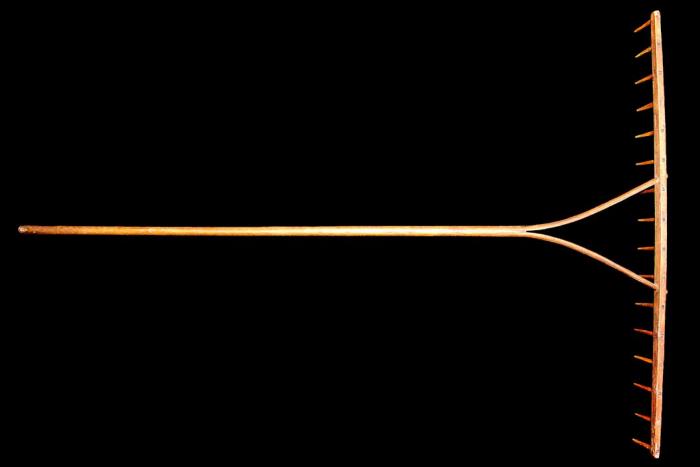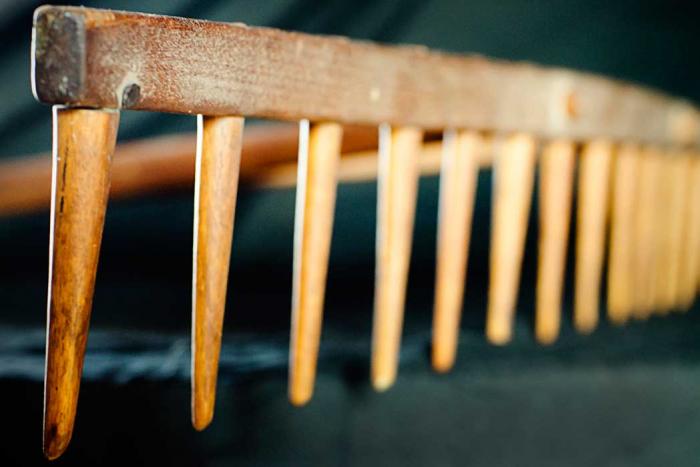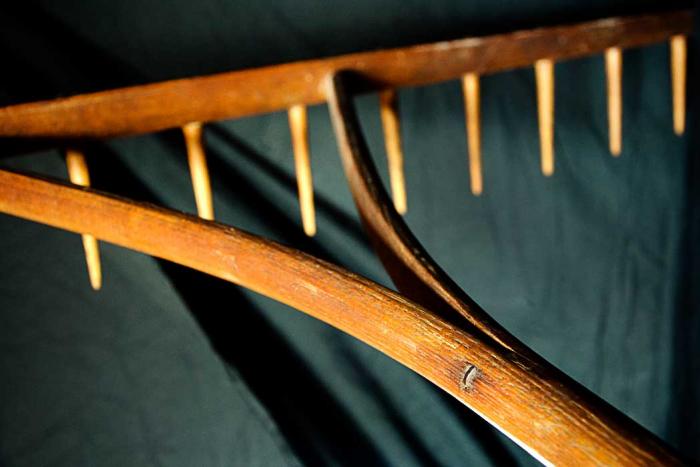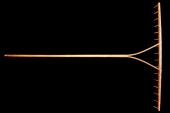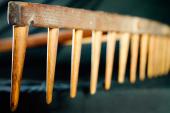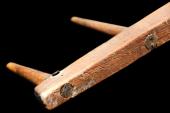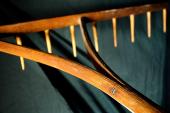Krutz Brothers Hay Rake
Organization: Pontiac Historical Society
Coordinates: www.diddleyvision.com/history/PontiacMuseum.html
Address: 210 Lake Street, Shawville QC J0X 2Y0
Region: Outaouais
Contact: Robert Wills, rlandonwills(a)aol.com
Description: Handmade hay rake made by one of the Krutz brothers who farmed in the German-speaking settlement north of Ladysmith, Quebec.
Year made: circa 1920s
Made by: Handmade by one of the Krutz brothers
Materials/Medium: Oak or ash wood
Colours: Brown
Provenance: Ladysmith, Quebec
Size: 175.2 cm x 120.6 cm with 16 wooden teeth 12.7 cm in length
Photos: David Irvine. Courtesy Pontiac Historical Society
Krutz Brothers Hay Rake
Robert Wills
This hay rake was hand-made by one of the Krutz brothers, who lived in the "Old German Settlement" area north of Ladysmith, Quebec, in the 1920s. The handle is175.2 cm (69 inches) long and sawed and shaped from hardwood, probably oak or ash indigenous to the region. The head of the handle was sawed, then steamed and bent outward to fit into the head of the rake, at a spacing of around 30.4 cm (12"). The head is 120.6 cm (47½ inches) long, and fitted with 16 wooden teeth 12.7 cm (5 inches) in length. The teeth were set into the head and splined at the top, held fast by driven wooden wedges. The only piece of metal in the rake was a wire staple to stop the handle splay from splitting any further.
There were five Krutz brothers, bachelors all and sons of Henry Krutz. Victor Krutz lived and worked on the farm of Nelson Schwartz and Walter Krutz died as a young man. Three brothers, Wallace, Vernor and the youngest, Gordon lived at the old farmstead north of Ladysmith, east of Otter Lake, in an area sometimes referred to as the brule. One of the brothers or perhaps even their father, fashioned the rake out of wood. It seems likely that all of them had opportunity to put in a day's work with it.
In the 1960s, the three Krutz Brothers relocated to a place near Portage-du-Fort, where the soil was much more fertile. It is said that they returned at times to visit old friends and teased the German Settlement folks about how grasshoppers would pack a lunch before travelling across the poor rocky and sandy lands of the old homestead. When they closed their farm, the Krutz brothers sold some articles at an auction. Keith Harrison, who owned a summer home nearby, bought the rake for $2, as a keepsake of his friends. He kept the rake until 2009, when he donated it to the Pontiac Museum. The Krutz house and buildings are still standing and are now owned by a neighbour.
The German Settlement around Ladysmith was an enclave of immigrants and their descendants. They brought their Old World craftsmanship to the sandy hills of Thorne Township, clearing fields and building farms, toiling long evenings to fashion tools to work long days.
Three main cultural groups were drawn to the Ottawa Valley in the early 1800s – the Scots, French Canadians and the Irish. Other groups settled later in the Ottawa Valley, including French-speaking Presbyterians, Belgians, Swiss, Italians, Germans, Poles, and United Empire Loyalists. Most of these smaller groups remained relatively distinct, settling together, retaining their own language, and often establishing their own churches.
Farming, forestry and canal building complemented each other and drew thousands of immigrants with the promise of a living wage. During this period, Irish, French Canadians and Scots arrived in the greatest numbers and had the most significant impact on the identity of the Ottawa Valley. In the mid‐19th century, two distinct German settlements were established near Shawville, Quebec, and in the lower Lièvre River valley. Many of these German Lutheran pioneers were from the military and had exchanged their commissions for land in Quebec. They chose land “high and dry and went up to the hill country and found what they sought and built the village of Schwartz” (later renamed Ladysmith).
Greermount, Thorne Centre, Thornby and Schwartz (Ladysmith) became the hub of Thorne Township and the destination for German-speaking immigrants wishing to establish themselves in Quebec. Today close to 80% of the family names found in this region have ancestral ties to these first German settlers.
Thousands of European immigrants came to Quebec in the mid-19th century and early 20th century. Attracted by the promise of work and freedom, people whose first language was not English or French left indelible marks on the cultural and linguistic landscape of the province. While they spoke their mother-tongue in the home, these new settlers often chose English as their second language to educate their children, to socialize and conduct business outside of their communities.
The legacy of the German settlers in the Outaouais includes log buildings still standing plumb and true, though the fields have returned to forests, as back-country farming yielded to modern methods, more suited to the open lowlands, nearer to highways.
The “German settlement” where the Krutz brothers worked and established their home and farm retained the customs, music, language and traditions of the first settlers. As late as 1950, young people from this community who were starting school had to first learn English, as German had been the common language of their elders. Even today Oktoberfest celebrations in Ladysmith pay tribute to the strong German influences in the region and the sound of German-speaking voices can be heard clearly in the crowd.
Sources
The Ottawa River, http://www.ottawariver.org/pdf/08-ch2-6.pdf
Ladysmith, www.ladysmithoktoberfest.ca
Thorne Quebec, http://www.thornequebec.ca/history.htm
To Learn More
R.A. Helling, A Socio-Economic History of German-Canadians: They, Too, Founded Canada, 1984.
G.P. Bassler, The German Canadian Mosaic Today and Yesterday: Identities, Roots, and Heritage, 1991.
Virtual Museum of Canada, http://www.museevirtuel-virtualmuseum.ca/sgc-cms/expositions-exhibitions...
Waterloo Centre for German Studies, https://artsonline.uwaterloo.ca/wcgs/
Author
Robert Wills is a director and past president of the Pontiac Historical Society.


